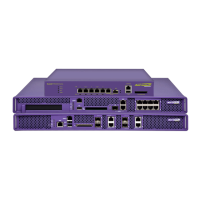Summit WM3000 Series Controller System Reference Guide 189
5 Select OK to save the changes to the AP’s mesh configuration, or select Cancel to revert to the
previously saved configuration.
Viewing AP Statistics
Refer to the Statistics tab for information and high-level performance data for individual radios.
Performance information can be reviewed for either a 30 second or one hour interval. Use the Details
button to display additional information for an individual radio.
To view Radio Statistics:
1 Select Network > Access Point Radios from the main menu tree.
2 Click the Statistics tab.
Base Bridge
Select the Base Bridge checkbox to allow the AP radio to accept client
bridge connections from other access points in client bridge mode. The
base bridge is the acceptor of mesh network data from those client
bridges within the mesh network and never the initiator.
Maximum no. of
Client Bridges
Define the client bridge load on this particular base bridge.
Client Bridge
Select the Client Bridge checkbox to enable the access point radio to
initiate client bridge connections with other mesh network supported
access point’s using the same WLAN.
Mesh Network Name
If the Client Bridge checkbox has been selected, enter a Mesh Network
Name to define the WLAN (ESS) the client bridge uses to establish a
wireless link. Extreme Networks recommends creating (and naming) a
WLAN specifically for mesh networking support to differentiate the Mesh
supported WLAN from non-Mesh supported WLANs.
Mesh Time Out
Define whether one of the radio’s beacons uses an uplink connection. The
Mesh Timeout value is not available on a single-radio AP, since the radio
would have to stop beaconing and go into scan mode to determine if a
base bridge uplink is lost. The following drop-down menu options are
available:
Disabled
- When disabled, both radios are up at boot time and beaconing.
If one radio (radio 1) does not have a mesh connection, the other radio
(radio 2) is not affected. Radio 2 continues to beacon and associate
MUs, but MU's can only communicate amongst themselves using the
access point. Disabled is the default value.
Uplink detect
- The AP only boots up the radio configured as a client
bridge. The AP boots up the second radio as soon as the first mesh
connection is established. However, if the client bridge radio loses its
uplink connection, the second radio shuts down immediately. Uplink
detect is the recommended setting within a
multi-hop mesh network.
Enabled
- If the mesh connection is down on one radio (radio 1), the
other radio (radio 2) is brought down and stops beaconing after the
timeout period. This allows the client bridge (radio 1) to roam without
dropping the MU's associated to radio 2. The disadvantage is that radio 2
may beacon for the timeout period and have to drop associated MU's
because radio 1 could not establish its uplink.

